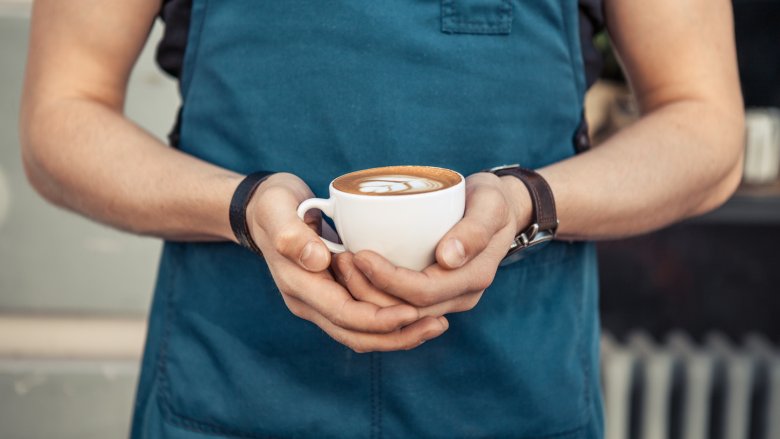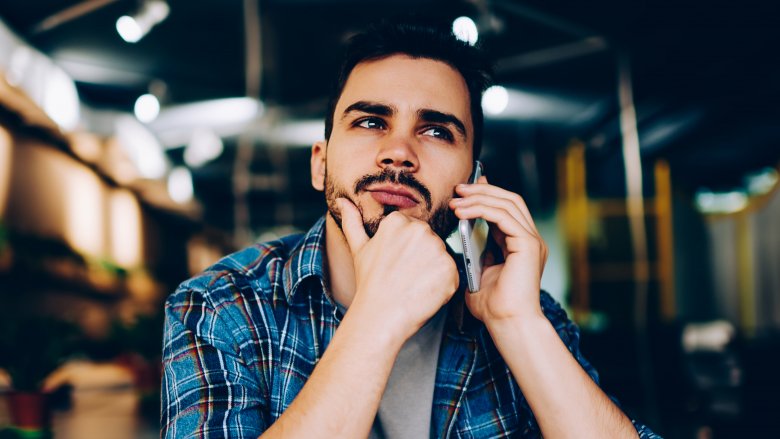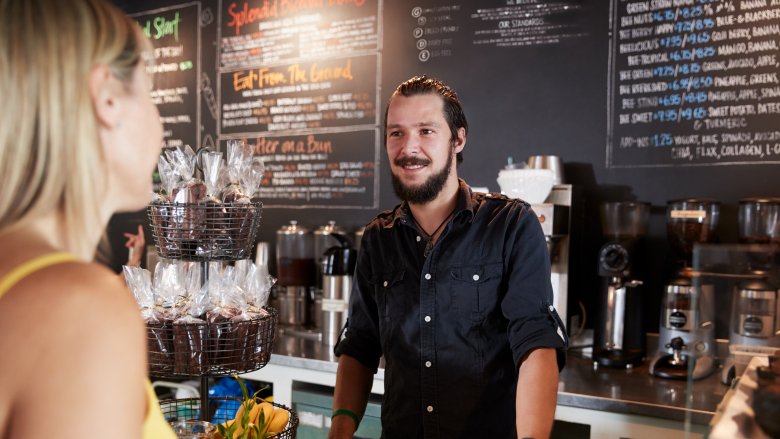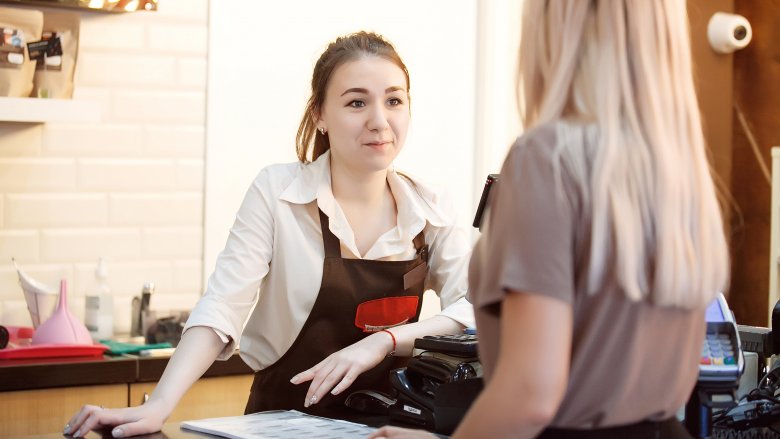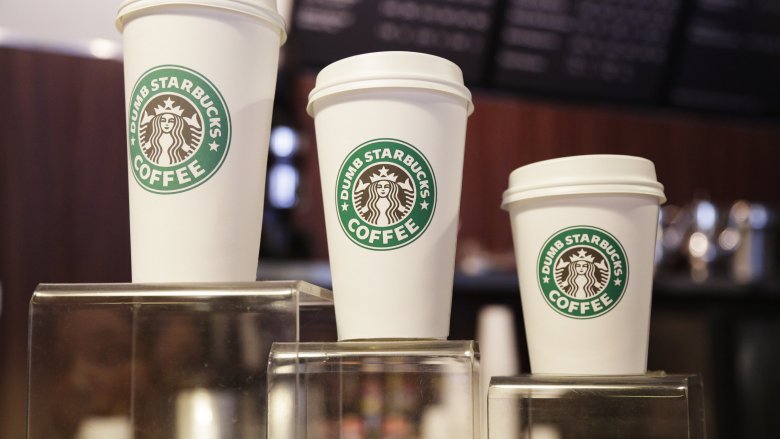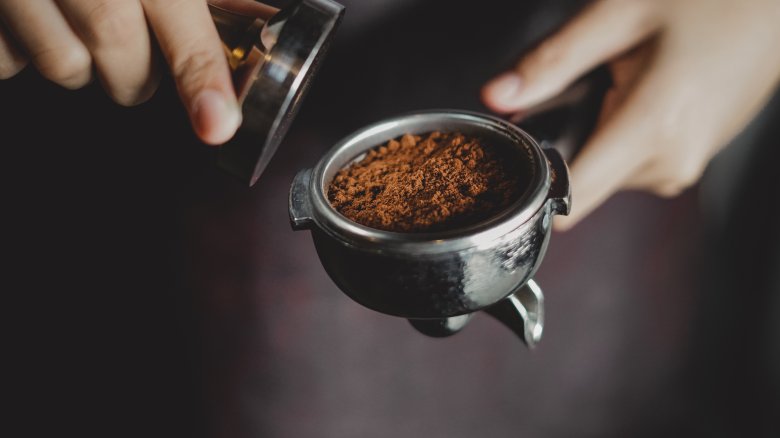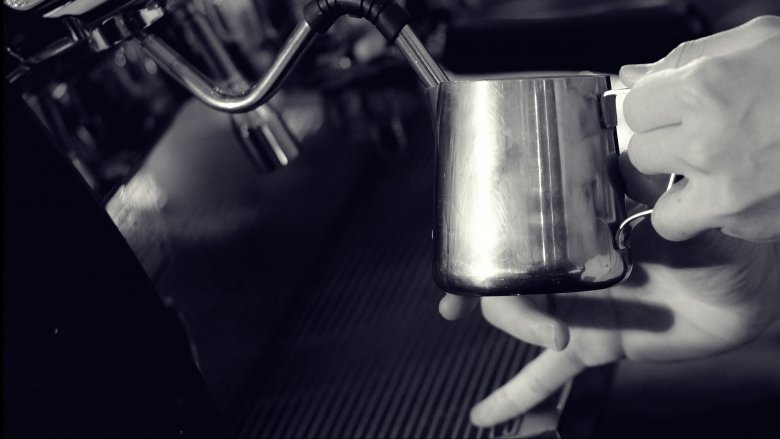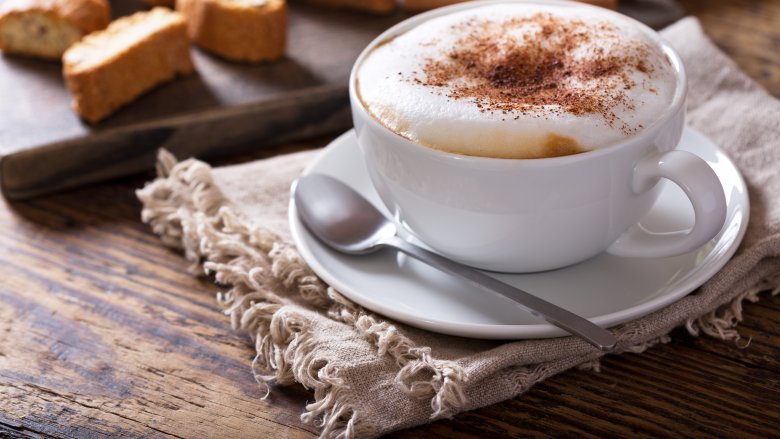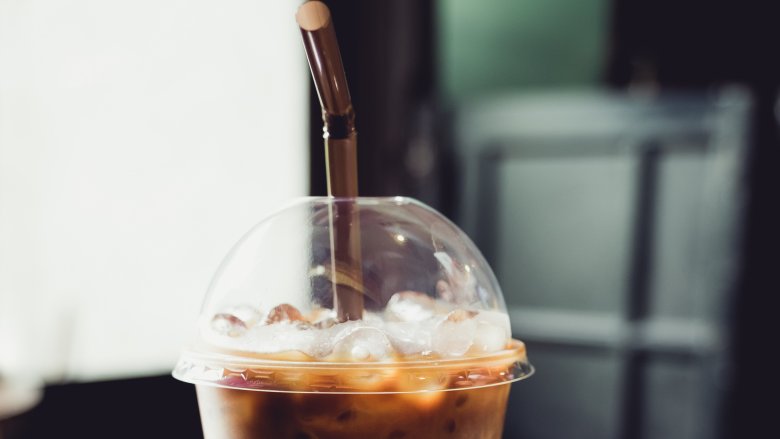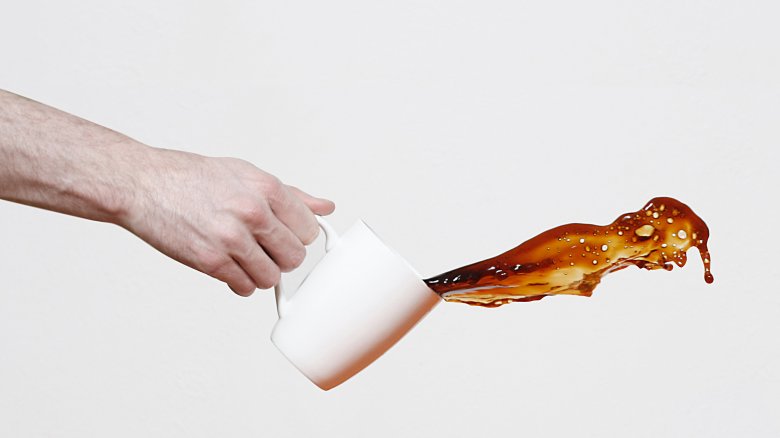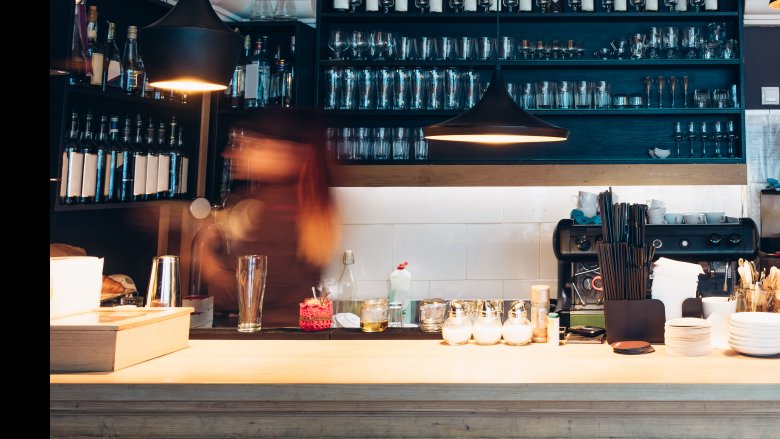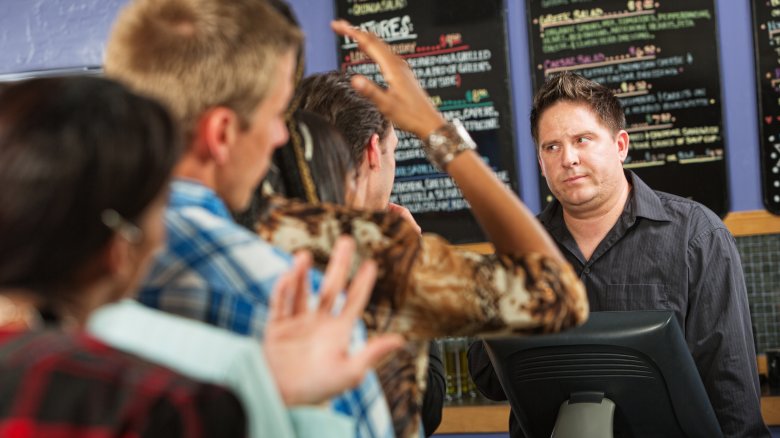Things Your Barista Wants You To Stop Doing
Capable of conjuring Instagramable butterflies out of steamed milk, remembering your seven-ingredient-long drink order, and keeping cool when faced with a queue of caffeine-fiending customers, baristas may seem superhuman.
But these coffee-slinging saints aren't made of steel. Even the best baristas aren't impervious to grouchiness. Or obnoxiousness. Or just-plain rudeness. Behind their cheerful smiles, baristas are ticked off by certain common customer behaviors—some of which you may unwittingly be guilty of yourself. (Apparently, waiting until you reach the register to decide what you want so you can ask the super sexy barista, "Gee, I can't decide! What's your favorite drink?" is not as cute as I thought.)
Turns out, many of us well-intentioned but totally clueless customers are driving our baristas nuts to the point where they're flocking to social media platforms to gnash their teeth and curse our names. We've rounded up some of the most common coffee-shop offenses in our list of things your barista really wants you to stop doing.
Ordering while on the phone
Whether you're ordering a coffee, paying for a pair of shoes, or buying a packet of Red Vines, the laws of basic human decency dictate that you stop your phone conversation when interacting with another living, breathing, feeling person. Staying on the phone while whispering your order to your barista is rude both to your barista and the person you're talking to. And yet it's so common that some cafes put up signs banning the use of cellphones at the register.
So what do you do if you're in line and you get a phone call from Matt Damon asking you on a date or Mark Zuckerberg offering you a job as Facebook's official chocolate taster? This seasoned barista blogged that it's acceptable to tell the other person on the line to hold on a sec, put down your phone, place your order, and then resume your gabbing. If you don't want to put Mark Zuckerberg on hold, step out of the line to finish your conversation.
Responding to their greeting with your drink order
Pop quiz: When you reach the register and the barista asks you how you're doing, how do you respond?
A) "Almond milk cappuccino. Tall."
B) "Half-caff. Medium. To-go."
C) "Um, do you serve coffee here?"
D) "I'm great [name on their name-tag], and I'm about to be even better thanks to the delicious cup of coffee you are about to lovingly craft for me! How are you?"
If you picked D), you passed the I am not a heartless coffee-fueled robot test! It may seem obvious enough, but ignoring your barista's greeting and barking out your order is common enough to have baristas bummed. When Mental Floss interviewed baristas at the New York Coffee festival, participants explained that disregarding their greeting is a surefire way to tick your barista off. Do you want to upset the person who's about to make the caffeinated elixir you need to function? "Be nice to your baristas, or you get decaf," another interviewee warned.
Not being ready when it's your turn
You've been waiting in line for ten minutes. There's a giant menu of items right in front of your face. Don't act surprised when you finally reach the register and are expected to know what you want to order. While you're deliberating between a flat white, a chai latte, or a caramel swirl frozen mocha with whipped cream, your barista and all the customers behind you are mentally shooting laser beams at your head.
The same goes for being prepared to pay. If you've been waiting in line, have your wallet ready, as one barista begged customers in a Today Food interview. You knew this transaction was coming. You shouldn't start digging through your giant backpack or doing the frantic pocket patting dance after your barista tells you it'll be $4.95. Particularly during peak hours, taking an extra five minutes to order and pay can slow down the line and make your barista (and everyone behind you) inwardly curse you and your firstborn child.
Not specifying a size
This one seems harmless enough. You just recited five of your coworkers' complicated drink orders, which included multiple types of milk and sugar-free syrups. You're basically a hero. Does it really matter that you forgot to specify drink sizes?
To baristas, who reportedly have to ask as many as one-third of all customers what size they want, it does. Repeating "what size would you like?" to one out of three customers all day long, day after day, could drive even the friendliest barista mad. Not to mention, if they have to write the order on the cup, it would be helpful to have that cup in-hand before you start firing off your order details.
One last thing about coffee sizing: if you're confused by the size options at a place like Starbucks that confusingly calls its sizes "tall," "grande," and "venti," it's okay to use regular terms like "small" and "medium." Your barista will understand what you mean. On the other hand, do not try asking for a "grande" or "venti" at other cafes outside of Starbucks. One barista equated this to "calling your new lover by your old lover's name".
Pronouncing it "expresso"
Along with gyro, beignet, and pho, "espresso" is one of the most commonly mispronounced food words. That means your average barista hears people order an extra shot of "expresso" constantly without being able to say anything, because "the customer is always right" even when they're actually painfully wrong. The mispronunciation exasperates coffee connoisseurs enough to merit its own Reddit thread, where baristas gripe that even newbie coworkers are known to mispronounce the word.
How did the mispronunciation get started? Some theories postulate that English language-speakers assume the word is related to "express," referring to the speed at which the drink is made or the rate it introduces sweet, sweet caffeine into your system. In fact, the word comes from the drink's original Italian name, cafe espresso, which translates to "pressed coffee." The correct pronunciation replaces the "x" with the "s" sound: es-press-o. Say it with me. Esssspresssso.
Ordering milk-based drinks "extra hot"
As one veteran barista explained to Business Insider, ordering a milk-based coffee drink "extra hot" can ruin the flavor and texture of the milk. Because of dairy's chemical makeup, it's best served between 145 and 165 degrees Fahrenheit. Steaming milk correctly within this temperature range gives it a rich flavor and velvety texture.
On the other hand, if you steam the milk to excessively high temperatures, you can cause its natural sugars to breakdown. As a result, the milk will be less flavorful and rigid and dry in texture.
You're not doing yourself any favors by ordering non-dairy milk alternative-based drinks extra-hot, either, apparently. As this Australian barista explains, soy milk is especially sensitive to high temperatures, which can break down the proteins and result in a curdled soy latte. Sticking between 130 and 140 degrees Fahrenheit is apparently the trick to steaming smooth, perfectly frothy soy milk.
What about soy milk's trendier non-dairy cousin, almond milk? Reportedly, almond milk can be heated a little higher than soy milk, but should be steamed at a lower temperature than cow's milk (below 150 degrees Fahrenheit) to avoid bringing out a bitter taste.
Ordering a "no-foam" cappuccino
A cappuccino, by definition, is made with a balance of espresso, steamed milk, and milk foam. It's the blend of all three ingredients that makes a cappuccino a cappuccino, and gives the drink its signature texture and slightly stronger coffee flavor.
With cappuccinos, the texture of the milk foam in particular is critical. The foam is created with a steam wand that forces steam and tiny bubbles of air into the milk to make its signature fluffy froth. A "wet cappuccino" comes with more steamed milk and less foam, while a "dry cappuccino" has less steamed milk and more foam.
So after this mini lesson in cappuccinos, you can understand why some Reddit baristas say they die a little inside when someone waltzes up to the counter and orders a "no-foam cappuccino". It's like ordering a no-cheese cheeseburger. Or a no-vodka vodka tonic. Or a non-denim pair of jeans.
For future reference, if you do want a drink similar to a cappuccino but without foam, try ordering a "flat white."
Trying to hack or scam your way into a cheaper drink
There are a few "hacks" customers reportedly use to score cheaper coffee drinks. For example, there's the poor man's latte, which involves ordering espresso on ice, then going to the condiment bar and pouring half the container of cream into your cup. Then there's the refill scam, which involves bringing old Starbucks paper or plastic cups into the cafe to take advantage of Starbucks' 50 cent refill policy. In one particularly cringe-worthy case, a coffee scam involved the man buying 365 Starbucks cards and registering them online with different birthdays in order to get a free birthday drink every day of the year.
Your baristas might not say anything. But they're onto your tricks and silently judging you. It's true that massive corporations like Starbucks can handle a few people making DIY ice lattes by hogging all the cream at their condiment bar (although it doesn't make it right) — but pulling that crap with your local mom-and-pop coffee shop is definitely not cool, and not worth the meager amount of change you save.
Pouring coffee into the trash
Funnily enough, there's a reason baristas usually ask you if you want room for cream. It's because they want to prevent you from what everybody and their mom ends up doing when their coffee cup is too full: dumping the excess liquid out into the trash can. The custom is so prevalent that some cafes are even putting up signs over receptacles pleading with customers not to empty their drinks into the trash.
Their plea to keep coffee out of the trash is reasonable if you think about it. Liquids, particularly piping hot ones like coffee, can tear and leak through the trash bag. When this happens, the poor soul taking out the trash has to drag a heavy bag full of liquids and mop up a leaked trail of gross old coffee afterwards — plus someone has to clean out the nastiness at the bottom of the empty trash can.
The solution: tell your barista how much room you'd like in your coffee when you order. If it's too full, ask him or her nicely to pour some out in the sink.
Reaching across the bar
You may be in a hurry. You may not give it a second thought. You may even think you're helping the barista by reaching over to grab a lid, spoon, straw, sleeve, caramel syrup bottle, cinnamon shaker, etc. from behind the bar yourself.
But grabbing anything from behind bar can cause a few problems, explains one barista. Touching a stack of lids or a bundle of straws can contaminate the whole batch, forcing the cafe to toss the entire bundle to prevent the spread of germs.
Plus, think of how annoying it'd be if your barista showed up at your place of business and grabbed a handful of paper clips or started messing around with your toy drinking bird thing that bobs up and down. A barista's bar is their workstation, their artist's studio, their workshop where they create creamy, caffeinated masterpieces. Show some respect by not getting your paws all over their space. If you need something, wait your turn and ask politely, and your barista will likely be happy to oblige.
Explaining that you're in a hurry and need your drink first
There's a good chance that nearly everyone in the coffee shop during the morning rush is in a hurry. Generally speaking, people don't scurry into a coffee shop at 7 a.m. to stand in line for 10 minutes for a massive jolt of caffeine because they're planning to go take a leisurely nap in a field of dandelions.
So don't try to rush your barista by explaining that you're in a hurry and definitely don't ask them to make your drink first. As one Starbucks barista explains, baristas make drinks in the order they're received, so you'll have to wait your turn just like the rest of the busy bees. If you're running late for your sister's wedding, about to give birth, or happen to be a crime-fighting superhero who needs to go thwart a bank robbery, you probably shouldn't have stopped for coffee in the first place.
